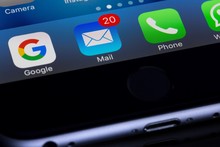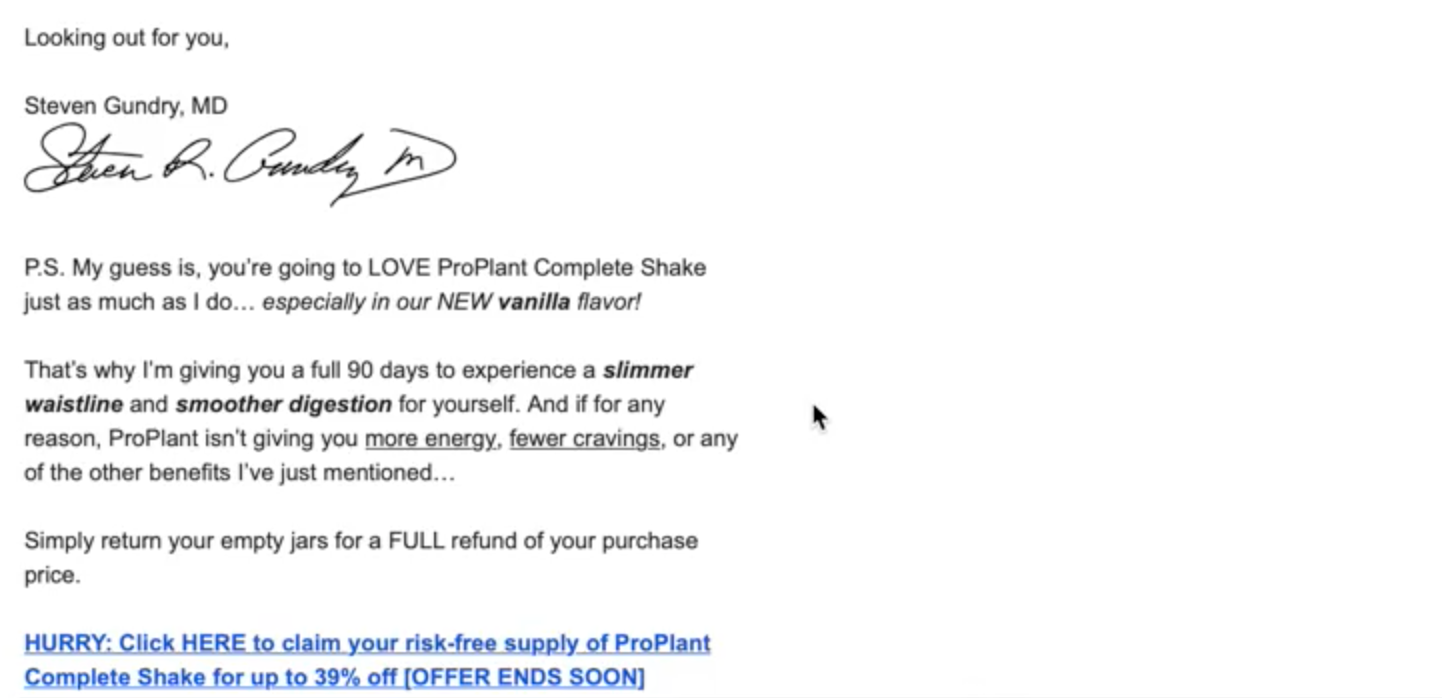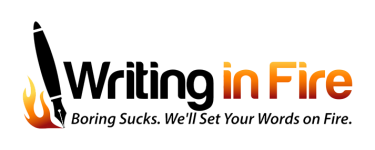Author Archives: Adam Napolitano
STOP Ruining “John’s” Nightmare!
Avoid this Conversion-Killing Mistake in Your Sales Letters and VSLs
- in copywriting , sales skills by Adam Napolitano
Copy Breakdown: 3 Takeaways from Dr. Marty’s Dog Food VSL

Studying another copywriter’s work is a great way to improve your own copywriting and direct response skills. In this week’s post, I’ll be breaking down the first 3 minutes of Dr. Marty’s dog food VSL.
I happen to stumble upon this VSL on Facebook where it is currently running as an ad. It’s a short 15 minute VSL that is packed with a lot of valuable copywriting and direct response tips. While you can watch the whole VSL here, I’ll be sharing the 3 biggest takeaways from the intro alone.
Before We Go On…
I like to consider Dr. Marty the Dr. Gundry of the pet health and pet food industry. And if you watch this VSL, you’ll easily see why. Within the first few minutes, you can already extract a lot of information and value that you can apply to your own copywriting, marketing, and direct response efforts, like…
Takeaway #1: Opening with a compelling story or factoid
Right off the bat, this VSL opens with a compelling factoid about how dogs are descendants of wolves. While that isn’t necessarily the interesting fact, Dr. Marty goes on to explain that because of this lineage, the only way dogs would have access to grains, vegetables, and fruits are through the inner contents of their prey’s stomach. This interesting factoid will have viewers thinking about what is in their pets’ dog food. Which brings me to the second takeaway…
Takeaway #2: Introduce a cool mechanism behind the problem
If the viewers aren’t already thinking about what the ingredients of their dog’s food contain, Dr. Marty introduces an intriguing mechanism — the 3 dog food health disruptors. This sets the stage for Dr. Marty to introduce the problems with most dog food on the market, including the high-quality, premium grade brands. According to Dr. Marty, most dog food brands out there contain at least 1 of the 3 dog food health disruptors without you even realizing it.
Takeaway #3: Tease your viewer’s fascinations
At this point, any pet owner would be hooked in to the VSL, waiting to hear about the 3 dog food health disruptors, how it affects their dog’s health, and what they can do about it. This is when Dr. Marty and his team decides to tease their viewers’ fascinations by promising to reveal the one meat humans eat that we should never feed our dogs. What’s more, they also promised to reveal one common type of dog food in the United States that is missing a critical vitamin that your dog needs to have a healthy heart. If you’re a dog owner, chances are… you’re hooked!
Incredible Value Within the First 3 Minutes
One thing that Dr. Marty and his team could split test, if they haven’t done so already, is to open the VSL with a heart-wrenching, emotional story, instead of the factoid about wolves and dogs. Because Dr. Marty has experience as a working veterinarian, he could share a patient story of a dog’s tragic health issue that he was able to solve by identifying one of the dog food health disruptors as the cause.
Idea aside, this VSL is incredibly informative and filled with great examples for anyone who wants to write high-converting copy. If you’re a copywriter, add this video to your swipe file immediately! As you can see, the copywriter on Dr. Marty’s team completely understands the principles and fundamentals of long-form sales copy and direct response.
3 Incredibly Powerful Page Optimizers that Can Improve Conversion Rates

Recently, I worked with a client on a VSL (video sales letter) for their joint pain supplement. The initial results of our work did pretty well, especially when compared to the old control. However, the conversion rate was still below what we were all expecting. We came up with a plan of action but there were several on-page issues that may be the cause of a low conversion rate.
Looking at the funnel, sales page, and where they were sending their traffic — I was able to identify immediately the on-page issues that were responsible for the less than desirable conversion rates.
If you’re a fellow copywriter or an owner of your own health supplement company, it might be tempting to dive right into the sales copy and VSL to see where you’re missing the mark. And if this issue sounds a little too familiar to you… you might want to take a look on your sales page to see if these 3 powerful, yet simple, on-page optimizers are in order.
1st Conversion Rate Optimizer: Your Headline
The headline on my client’s sales page read “Use this 10-second trick to kill joint painâ€. The main issue here is the headline has nothing to do with my VSL. What’s more, it’s way too hyped up. The chronic pain market is already skeptical and bitter because they’ve been in pain for years, tried so many different options, and haven’t found a remedy. In other words, their BS meter is through the roof. Claiming you have a 10-second trick that can solve years of joint pain is going to turn off a lot of your audience. They won’t even bother watching the VSL.
On the other hand, there may be a small group of people who felt compelled enough to pass through the headline and click play. Here’s where the next issue arises: there is no 10-second trick anywhere in the VSL. Your headline has now become a bait and switch. This is going to upset a lot of your viewers who clicked on the VSL, hoping to learn a 10-second trick that solves their problem, only to be disappointed when there isn’t one.
2nd Conversion Rate Optimizer: Your Video Thumbnail
Video thumbnails often get overlooked as a conversion rate optimizer. This is a particularly important element not to neglect, especially if your VSL isn’t on autoplay. The truth is, your thumbnail could either help or hurt you. You can always place an eye-catching image that relates to your target audience or use text as a point of persuasion.
The problem with my client’s thumbnail was the text they used. It read “the world’s greatest joint pain solution.†If you’re like me, you’re probably chuckling to yourself. Not only is this a very vague statement, it is also an incredibly generous one — which makes it kind of unbelievable.
Keep in mind, our prospects have yet to consume any of our statements yet, so why would they believe such a great claim? Ultimately, our thumbnail could have been a huge turn off for our prospects.
If you run into this problem, here are a few quick fixes that are sure to work. First, you could always use a great image if it relates to your ideal audience and their pain points. However, if you have a great headline, repeat it in the thumbnail, verbatim. Or, simply repeat the text used in your email if that’s where the source of your traffic is coming from. If the email text is compelling enough to get them to the sales page, it’ll get your audience to hit play on your VSL.
3rd Conversion Rate Optimizer: The Timing of What Appears Below Your VSL
My client had a cart button and FAQ immediately appear right below the VSL as soon as the sales page loaded. This sends your page viewers a message that yes… you do in fact have something to sell them. This is an immediate turn off and it will prevent them from watching any of your VSL.
Thankfully, the remedy for this is simple. You’ll want to delay the appearance of the add to cart and FAQ until the product has been introduced. But ideally, you’ll want it to appear at the point where you reveal the price and state the first call to action.
Not Seeing the Conversions You Want?
Before you dive into your copy, make sure these 3 simple on-page optimizers are working in your favor. It may seem obvious, but sometimes the most skilled professionals tend to overlook simplicity. Instead, they work on the hard stuff over and over again, without noticing that simple on-page optimizers may be their problem after all.
Use This “Secret” Lead in your Sales Letter to Hook your Visitors Immediately

Ask any copywriter what the most important part of a sales letter or VSL is and you’ll get a different answer. Some would say “it’s all about a powerful, emotional story.†Others will say “it’s all in the offer!â€
I’m here to tell you that they’re all wrong! The most important part of any sales letter is in the headline and the lead. How can I say that with so much confidence?
Well think about it this way — if your prospects can’t get past your headline or lead, they’ll never get to your offer or your story, no matter how great they are.
Is Your Headline or Lead Working For You?
We all know what a headline is. But as for a lead, that is the first 100–600 words of your sales letter. For a VSL, that usually tends to occur in the first 4 minutes of your video.
Thanks to the internet, you can now track how long your prospects are consuming your sales letter or VSL for. An effective headline and lead will keep your prospects on your sales letter for more than 30 seconds. And your VSL? A great headline and lead will keep them viewing for 4 minutes or more.
Here’s Why Your Headline and Lead Are the Most Important Parts of Your Sales Letter or VSL
If you botch your headline or lead, you’ll lose visitors right off the bat. If you miss the mark, you have not succeeded in grabbing your prospect’s attention. They are not going to continue reading and watching and you just lost that potential customer. If you’re screwing up your headline and lead, they won’t get far.
If you’re writing your own copy or you’re hiring someone to do it for you, you need to know what makes a great lead so you know what to look out for.
The Secret Lead
You need a compelling headline that moves into a great lead.
This is why the Secret Lead is a simple and effective method to start off your sales letter. It’s a great technique for converting cold traffic with lots of universal appeal.
The secret lead is a commonly used technique in direct response copywriting. It’s similar to dangling a juicy carrot right in front of your prospects. For the secret lead to work, it needs to:
- Be intriguing — there needs to be curiosity, shock, and excitement that grabs your prospect’s attention.
- It needs to communicate a desirable benefit — it needs to be something that your ideal customer actually want.
Here’s an Example
Let’s take a look at how you can use this technique directly in the headline, using an example from Michael Masterson and John Forde’s book, Great Leads.
This example is a headline from a real sales letter that is targeting investors.
Example headline: “Closed to new investors for the next 6 years, now open again. The Chaffee Royalty Program that turned every $1 into $50.â€
That first sentence alone is incredibly intriguing. If you’re an investor, you may be thinking “why was it closed? Was there controversy? What happened?â€
Additionally, the very mention of the Chaffee Royalty Program also piques your readers’ curiosity. It’s mysterious and has a sense of exclusivity.
Now to the benefit — as an investor, you’ll be interested in turning $1 into $50. That’s a 50 times ROI!
See how this simple headline is jammed packed with lots of factors that raises curiosity?
A Few Tips
The secret lead is universal and can be applied to any sales letter or VSL you write. However, less experienced copywriters tend to make this one mistake — spilling the beans a little too early.
They come up with a great secret lead in the headline, only to reveal all their secrets 2–3 sentences into the lead. If you do that, you scratch your readers’ curiosity itch. And once that happens, they’ve got what they needed and will leave before finishing the rest of the sales letter.
If there’s no more mystery and intrigue left, your prospects are going to leave. So do not spill the beans too early! Study successful direct response sales letters to see how the greats hold on to that sense of intrigue until the very end.
Why Use the Secret Lead
If people who don’t know who you are come across your sales letter, they have no preexisting trust built with you or your brand. The secret lead will get their attention right away, hooking them into your sales letter. If your offer is strong, and you have an emotional story you know will resonate with your target audience, the secret lead will keep your prospects around longer. And as they keep reading or watching, that sense of trust with you and your brand be instilled at the end of it.
How Negativity Can Help You Stand Out When Writing Your Copy

If you’re a marketer, entrepreneur, or small business owner… you’re probably writing a lot of copy. Whether you’re writing a headline or hook for your website, a sales letter, an authoritative blog post, or a social media post — there’s a simple technique that not a lot of your competitors are using right now.
If you want to write engaging and captivating copy, here’s why you should consider using a little negativity.
Why Negativity Works
We tend to write copy that blatantly expresses the benefits of what we offer. We write headlines that include phrases like “Book More Clients†or “Increase Revenue.†It’s the obvious, common thing to do. There’s nothing wrong with including these phrases in your copy, but it doesn’t help you stand out from the competition. Instead, you end up blending in with everyone else.
In fact, a negative spin could work in your advantage when it comes to writing copy.
Imagine This…
Say you’re selling social media management services for dentists. These dental professionals and practices are your target audience, so you’ll probably write a headline like this:
“Discover how to generate 20 new patients every month using these simple Facebook techniquesâ€
This isn’t a bad headline at all. It will stimulate curiosity and maybe land you a few dental clients. The problem is your competitors are writing copy that look just like this. And your target audience (dentists) are probably used to seeing and being pitched to with types of headlines. Sooner or later, you’re going to be lumped in with everyone else they come across.
It’s All About Standing Out
This is where you’ll be able to use a negative spin to help you stand out from the crowd. Using that same headline, you could reword it like this:
“these 3 common mistakes cost the average dentist at least 20 patients every month. How many patients are you losing out on?†Or “how many patients are you losing?â€
This isn’t a perfect example, but you can already see a huge difference.
There’s a reason why this headline is making you slightly anxious. You may even be feeling a sense of urgency.
Reframing That Same Concept in a Negative Light
That one simple change shifted the focus on a loss instead of a potential gain.
Negativity is a simple and powerful tool to intrigue and engage with your target audience, because the fear of loss is often more motivating than the idea of a possible gain.
Fear of loss, or fear of missing out (FOMO), is an extremely powerful motivator. And to be honest, I don’t see this technique being used often enough.
If you aren’t utilizing negativity in your copy, you’re missing out on capturing more of your audience’s attention. You’re also lumping yourself in with the rest of your competitors. Start implementing this simple, yet powerful technique to your copy. Not only will it help you stand out, it will help you increase conversions as well.
[thrive_leads id=’846′]Why “Blending in” is a BIG Mistake for Your Brand

One of the biggest reasons why businesses struggle to grow and bring in new clients and customers is because they pay too much attention to their competitors. You’d be surprised at how many people suffer from copycat syndrome.
Imitation is Not Flattery
Let me explain — whether a new brand is just starting out, or an established brand is going through some difficult times of struggle and stress, they tend to turn to their competition to analyze what their competitors are doing.
These business owners look at their competition, track their steps, and end up copying what they’ve done whether they mean to or not. They think their competitors have figured it all out so why not save some time and do what they’re doing?
Here’s the Issue…
From a customer’s point of view, this is one of the biggest mistakes any business owner can make. Why? Because you make it a hundred times harder for your potential customer to choose you.
If you end up imitating what your 10–15 competitors are doing, you lump yourself into the sea of similarity. Suddenly, your customer is forced to sift through all these identical businesses to decide which one is best for them.
Not only does it make it extremely difficult for your potential customer, it means you’ve lost your brand’s mission, clarity, and what ultimately makes you the best possible choice.
Head in the Opposite Direction
I’m not saying don’t scope out the competition to see what they’re doing — instead, look at what they’re doing and head in the opposite direction! You need to position your brand in a way that is completely unique and will set yourself apart from everyone else.
By doing so, you place yourself in a league of your own. You’ll make it so easy for your customers to pick you and not your competitors. You separate yourself from the herd, no longer having to worry about your competitors.
So keep an eye on your competitor, but don’t fall for the imitation trap. Instead, use that information to help you create a unique and engaging way to connect with your audience. Grab your visitors’ attention and appeal to them in a personal way, cultivating the know, like, and trust factor.
Position yourself in a way that helps you break through the noise and clutter, leaving your competitors in the dust — making it easier for your customer and clients to always choose you.
[thrive_leads id=’846′]Why Clarity is King When You Want to Sell

I’ve been writing and producing a lot of content about copywriting. I’ve shared powerful strategies to help you maximize sales and revenue, how to amplify emotional impact in any story, even sharing techniques you should avoid. Unfortunately, all of that doesn’t matter if you’re lacking one thing — clarity.
If this seems pretty obvious to you, I understand. But I’m still amazed at how many times I’ve seen people make this huge mistake in their sales copy. Not having clarity and not knowing your customer is a surefire way to kill sales.
What is Clarity?
I’ve seen tons of businesses make this mistake. They release a great product but when asked who it’s for, they start to pause. Maybe they’ll stutter. Or if they’re being honest, they’ll say “I’m not sure… I think a lot of people can benefit from this product!â€
That is a recipe for losing a lot of money in paid advertising.
Before you even bring your offer to market, before you start paying for ads, you need to do your market research.
You Need to Know Who You’re Speaking to
Conducting your market research means you’re finding out who it is you’re speaking to. Gaining clarity on this is a must before you start to write any copy for your sales letter. You need to understand their pain, struggle, and how they’re looking to fix the problem they have.
If you don’t know how to speak directly to them, they’ll leave your sales page or VSL in a matter of seconds.You’ll kill your chance of ever making a sale if you don’t take the time to gain clarity on who it is this message is intended for.
Take the time to do proper market research before you try to sell.
No Time to do the Research? Hire a Professional!
As a copywriter, market research is a part of my job. I was working on some copy for a new information product in an entirely new market. Because I didn’t have the time to do the research myself, I hired a professional to get the job done.
He put together a great research document and highlighted the different pain points, what they struggled with, captured the language they use, and all the things you need to write effective sales copy.
This Goes Without Saying…
Before doing anything and spending any money on marketing, you need to get clear about who you or your product is serving. Clarity is king when it comes to selling your product and knowing who your ideal customer is.
And if you ever need a cheesy reminder, remember this sentence: Clarity is king when you want to sell your thing.
[thrive_leads id=’846′]How to Turn Your New Product Announcement into a Powerful Sales Email

So you have a new product you’d like to announce to your email subscribers. I hate to break it to you but generally, people aren’t that interested. Unless they’re sitting around, patiently waiting for that specific new product, the man of your subscribers just don’t care unless there’s something in it for them.
What should you do if you have a new product to announce and you want to capture the interest and intrigue of your readers?
Let’s take a look at Dr. Gundry’s new ProPlant Complete Shake flavor announcement as a great example of how you can turn an announcement into a powerful sales email.
The Intro

The intro starts off strong by emphasizing the benefits of their product. Phrases like “first (and only) weight management shake,†and the description of each serving delivering a boost of energy, management of cravings, and hitting weight loss goals builds interest in the reader.
Additionally, they’ve used urgency and scarcity as an incentive to strengthen the close.
Had this been a simple announcement, the email could’ve ended right here. But they took the opportunity to turn this into a sales email to help improve conversion rates.
Confronting the Common Enemy

In this section, the copy dives into the specifics of a popular protein source — red meat. It starts off by throwing stones at the common enemy, discussing how consuming too much red meat isn’t healthy.
It is pretty common knowledge that red meat contains the highest amount of protein. The copy throws out some frightening (but common) assumptions about red meat consumption with terms such as “heart disease, diabetes, and even death…â€.
To drive the point further, they use a strong proof element — a study from Harvard. This establishes great credibility and trust with readers.
The transition in this section is great as it enters the on-going conversation in the reader’s mind.
“Ok Dr. G — so where SHOULD I get my protein from?â€
To which they reply “certain plants and their seeds.†This is a somewhat controversial statement, as many consumers don’t think of plants as a rich protein source. This sentence keeps the reader’s attention and sets up the next section of the email nicely.
Not What You Think It Is…

To those in the know, it’s no great secret that certain plants and seeds are packed with proteins. If this wasn’t the case, there wouldn’t be vegans or vegetarians. Generally, when we think of plant-based proteins and food in general, we thi nk it’s good for us!
On the contrary… Dr. Gundry says, “Sadly, most plant protein powders and shakes are loaded with health-destroying lectins,†leaving readers at a loss for where to turn next.
Introducing the Unique Mechanism!


Dr. Gundry’s answer (or unique mechanism) are his 3 “power hitter†proteins. Not only do they get the job done of delivering healthy protein and avoiding lectins, but they bring additional benefits such as fighting aging, fatigue, and aiding in comfortable bowel movements as well.
The first sentence of t he 3rd slightly controversial protein “power hitter†— hemp, quickly dismisses objections and puts readers at ease. Since many people still associate hemp with feeling a high, the copy addresses the objection before stating the benefits, which keeps the reader around longer.
The Close


After introducing the “power hitters†or the unique mechanism, the close is strengthened by reinstating a sense of urgency, while reminding readers of the benefits that crush cravings.
Announcement Turned Powerful Sales Email
All in all, it’s a strong sales email. The copywriter took the opportunity to turn this ordinary announcement into a compelling piece of persuasive copy. They dug into the benefits and unique mechanisms while instilling a sense of urgency in their readers, making the email more interesting and ultimately — more persuasive.
[thrive_leads id=’846′]A Simple Trick for Writing Winning Headlines and Sub-headlines

Headlines and sub-headlines are incredibly important. For starters, it’s the first thing most prospects and potential customers read before even getting into the bulk of your copy. This is your one shot to grab their attention and compel them to keep reading. You want to make sure you get this right. A bad headline and subhead will turn a reader away even before you get a chance to communicate the benefits of your product.
To help you make the process of writing a headline and subhead complex easier, here is my favorite formula for producing a captivating, effective, and winning headline and subhead.
A Simple Approach
This formula keeps things simple. Instead of wracking your brain trying to decide what it is you want to put in your headline and subhead, this formula makes it easy.
It focuses on the most important elements needed to capture your prospect’s attention, ignite their curiosity, and get their desire burning before you even dive into the meat of your sales letter.
The Big Promise
Right off the bat, your headline should present the big promise or claim that is the driving force behind the promotion. This is a surefire way to capitalize on your reader’s main burning desire. If they are your target audience, their attention and interest will be captured immediately.
You can further strengthen your headline by introducing a unique mechanism. All the best promotions, especially in the health supplement industry, have a unique mechanism. Why? Because it acts as a differentiator. A unique mechanism will help your product come across as fresh, new, and exciting — ensuring that your product stands out from the crowd.
Once you’ve presented a promise that creates desire, pair it with a unique mechanism that cranks up curiosity to create a show-stopping headline.
On to the Subhead
One of the most common techniques most copywriters use when writing the subhead is to double down on the main claim of the headline. The subhead, more often than not, simply elaborates on the big promise.
This is an effective technique when done correctly.
However…
Embellishing your main claim can work against you due to the skepticism of your audience. If the promise in your headline is so big that it has the potential of coming across as unbelievable, elaborating and doubling down on it can actually hurt response and scare people away.
Keep in Mind
If you’re writing copy for a health supplement, it is important to remember that some of these consumers have ultra-sensitive BS meters. Especially in saturated markets with a bunch of gimmicks, such as weight loss.
A big portion of your audience is jaded and skeptical after being burned many times before.
Do This Instead
If you make a big, grandiose promise in your headline, your subhead needs to back it up with a strong proof element.
You can expand and elaborate on the headline if necessary, but providing a very strong proof element in the subhead will maintain the attention of skeptics, getting them to stick around to keep reading your sales message.
There are many types of proof elements at your disposal, such as quotes or endorsements from celebrities, experts in the space, statistics, or compelling study results.
If you want to kick things up a notch, use the names of recognizable and reputable universities (Yale, Harvard, any of the Ivy League schools). Nobel prize winners are another irresistible proof element that give instant credibility. If you take the time to do this research, it’s usually easy to find a link between one of these proof elements and an ingredient in your supplement. If this turns up nothing, look for a connection with your unique mechanism.
Simplicity Wins Again
Sometimes, the shortest body of text can be the hardest to write. Headlines and subheads do a lot of heavy lifting but can be tricky to write when you have so many options.
By sticking to this simple formula, you’ll eliminate a lot of time spent trying to decide how to craft a winning headline and subhead. This formula will ensure that your prospects are intrigued while minimizing skepticism.
[thrive_leads id=’846′]- in Uncategorized by Adam Napolitano
Want to Write a Harder Hitting Lead? Here’s What You Should Do!

Recently, I read a turmeric VSL (video sales letter) lead that was off to a great start. The approach the writer took was to highlight the difference between what made a turmeric supplement junk and what made one good. This was a great approach and direction, but if you were looking to make your lead a little harder-hitting, here’s a tried and true method:
Amplify Your Customer’s Curiosity Factor
The goal here is piquing your customer’s curiosity and snowballing it into fever pitch — giving the viewer no choice but to continue watching your VSL or reading your sales letter in order to satisfy that curiosity. But what methods can copywriters use in order amplify and build curiosity in our viewers and customers?
Digging Deeper and Getting Specific
A little specificity goes a long way. Dig deeper and get specific about major points and fascinations. The goal here is to give your audience more meat to chew on. To illustrate my point, here’s a segment from the original turmeric VSL lead:
“But the fact is, most turmeric supplements aren’t as effective as they should be and there are hundreds of turmeric supplements to choose from.
So how can you tell which ones work, which ones don’t, and more importantly…
What’s the best turmeric supplement for you?â€
Isolating the Major Points
This is an important point because nobody wants to waste their money.
People want to buy something that will work for them. They want to buy something that gives them results they can see or feel.
The problem with the statement above is simple — it’s pretty vanilla and not compelling enough.
Make it More Compelling by Focusing on Fascination
Here’s a hypothetical example of how the statement above could be better:
“A shocking new study from Columbia University has just revealed up to 70% of turmeric supplements may be worthless garbage.
In fact, you may be better off taking that new bottle and dumping it down the toilet.
But fear not, in just a moment, we’re going to reveal 3 red flags that instantly give away when a supplement is nothing but a cheap money grab.
Most people would never think of these things but once you’re in the know, you’ll be able to look at any supplement label and within 10 seconds, know if it’s a stud or a dud.â€
Why This Works
This statement gets very specific by providing statistics, mentioning credible institutions, and amplifying emotional impact. The mention of an institution like Columbia University instantly gave this statement credibility. By doing so, your customers and prospects are more inclined to continue watching because you’ve established credibility and trust.
Additionally, this statement is more compelling because of word choices that amplify emotional impact and livens up the copy.
Getting specific will help you make a more compelling argument, hooking your prospects in and piquing their interest.
Disclaimer
This hypothetical fix could be better and less wordy, but I encourage copywriters to dive deeper with emotion and specifics into the major points and fascinations of your health supplement copy.
If you are able to dig in and get more specific, you’ll be able to write more compelling copy by piquing interest and curiosity, turning a good lead into a great one that converts on cold traffic.
[thrive_leads id=’846′]